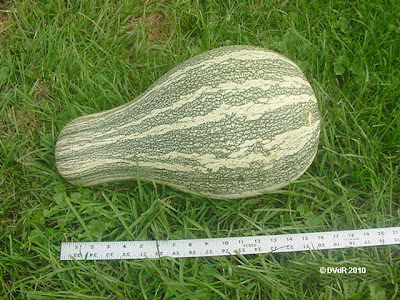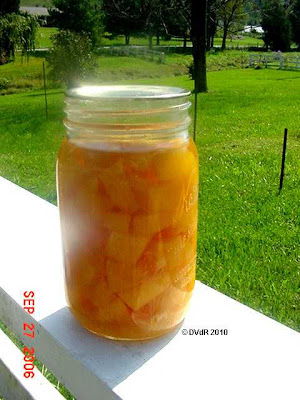Of all the things I grow in my garden, I think I love winter squash the best. It is one crop that I get to eat for several months exactly as it comes from the garden, simply because it stores well. All the other vegetables from the garden must have some kind of processing in order to eat them later... freezing, canning, dehydrating, fermenting or pickling, all of which require various amounts of my time, labor and often some expensive energy consumption.
With winter squash, all I have do is pick them, cure/harden them on the shady porch with good air circulation for about 3 weeks, and store in the root cellar. Easy-peasy.
Even growing them is easy: stick the plants in the ground in June, and start looking for squash in August. I do water occasionally if it's a very dry season, but other than that, I do absolutely nothing after planting except to hunt for squash under the umbrella leaves later in the summer. Usually I can harvest them from mid-August right up until just before the first frost.
Generally, I grow C. maxima and/or C. moschato, and have not had a problem with squash borers the way summer squash (C. pepo) do. This year I grew some acorn squash, C. pepo, and had some squash borer problems with them... but I did get a few fruit anyway. (Their stem is hollow, allowing the borer to lay eggs in the stem, killing the plant.)
Squashes can belong to 4 branches of the Cucurbitaceae family:
C. maxima (Hubbard, Banana, Buttercup, Turban or Turk’s Cap)
C. pepo (summer squashes like zucchini and yellow crookneck, plus Pumpkin, Spaghetti and Acorn)
C. mixta (Green stripe, cushaw)
C. moschato (Butternut)
Within a branch they cross-pollinate freely, plus Pepo crosses with Mixta and Moschato, and Moshatao crosses with Maxima.
Every year it's a quandary for me as to which winter squash to grow... there are so many and I always want to try them all! I like the vining types best, maybe because I love to see the vines march across the yard, escaping the prepared bed area. I prefer to grow heirloom and open-pollinated squash and I'm always looking for new-to-me heirloom squash to try. It helps promote genetic diversity, and allows me to save seed as well.
Generally, winter squash fall into the following types (and with several varieties within each type): Acorn, Butternut, Buttercup, Hubbard, Turk's Cap or Turban, Vegetable Spaghetti, Sweet Potato Squash, and Pumpkins (which includes a couple of hull-less seed varieties).
Here are a few I have grown with notes on them, although some of the photos are not mine.
 |
| Cushaw | | |
 |
| Half a cushaw, plenty of seeds to save or roast |
 |
| Canned Cushaw |
|
|
|
Cushaw was one of the first large winter squash I grew, and I no longer grow it merely because it is HUGE (10-12 pounds)! There is no way I can eat more than one cushaw, so if I want one, I get it at the farmer's market. Although the flesh was fine-grained and not stringy, I thought it was a tad watery.
I did pressure-can some cushaw in chunks for pumpkin pies; the majority of the canned "pumpkin" in grocery stores is a mix of winter squash and mostly cushaw, but seldom pumpkin because pumpkins are so stringy. It is not advisable to can pumpkin/squash as a purée ready for pies due to the density; heat may not penetrate into the interior of the jars enough to guarantee safe processing.
 |
| Tromboncino |
Tromboncino squash are edible but mostly a novelty. The ones I grew (by accident) came in a seed trade that were supposed to be something else. They can grow 3-feet long, and turn tan when cured. The seeds are only in the bulbous end. I gave one to a friend, who peeled and sliced a portion of the neck... breaded them and fried. He said they tasted like fried green tomatoes! Fine-grained, rather bland.
The Hubbard squash has been around in the US since the 1700's, mainly in New England. I haven't grown the Hubbard above (which looks like a Red Kuri), or even the Blue Hubbard below simply because they are too large for one person; most Hubbards range from 12-15 pounds. There is a
Baby Blue Hubbard that is to 5-7 pounds that I have grown.
All Hubbards are very tasty, fine-grained flesh. Store well.
I have not grown the
Banana squash,
popular in American pioneer gardens during the 19th century. Long, prolific vines produce squash 2-3’ long and weigh 10-40 pounds. Banana-shaped fruits turn pinkish-orange when mature, with firm, sweet, yellow-orange flesh. Excellent for pies, baking, and canning. 100-120 days.
The
Kakai squash sold by Johnny's is said to be hull-less so the seeds don't have to be hulled to roast. Seed Savers Exchange lists it as
Lady Godiva:
"This variety is specifically grown for its naked, hulless, greenish seeds. Very unique. Seeds are nutritious and rich in protein, great roasted or raw. Flesh is not suitable for eating, but they do make nice Jack-O'-Lanterns. Up to 3 ounces of seeds per fruit and 12-15 fruits per plant. 90-100 days."
I don't know this squash either (or where I got the photo long ago), but I'm going to order seeds this year. The size is right for me, and the description of a chestnut-like taste in intriguing! Seed Savers Exchange says: "Famous winter squash from France. Name derived from potiron (pumpkin) and marron (chestnut). Very aromatic and chestnut-like in taste. One of the very best for baking and roasting. Nice-sized 3-4 pound fruits store well. 85-95 days."
Another winter squash I plan to grow next year is the
Red Kuri, also known as Baby Red Hubbard and orange Hokkaido. (Follow link for photo.) It's a teardrop shaped red-orange squash from Japan, grows well even in a short season, weighs in at 3-4 pounds and stores well.
My favorite winter squash, at least so far, is the Waltham Butternut. "Prized for its uniform shape, rich dry yellow-orange flesh, nutty flavor and high-yielding vines. Fruits are 3-6 pounds and exceptional keepers. The result of years of patient refinement and selection by Bob Young of Waltham, Massachusetts. One of the most recognized types of baking squash. AAS winner in 1970. 83-100 days." I grow this squash every year, and have photos of my winter squash in a post yesterday titled "Garden Bounty".
Below is a favorite recipe for butternut squash, although I generally just bake them with a bit of butter like the photo above when there's just me and little time to cook.
Butternut Squash Chowder
Serves 6
1/2 pound smoked bacon, diced small (I have used less if the bacon is really smoky)
1/2 cup onion, diced small
2 tablespoons garlic peeled and minced
1/2 cup celery, diced small
1 cup carrots, peeled and diced medium
1/2 cup flour
1 bay leaf
2 cups butternut squash, peeled and diced medium
1 cup sweet potatoes peeled and diced medium
3 cups chicken stock (I use home-canned chicken stock)
1/2 cup red bell pepper, diced small
1-2 tablespoons fresh thyme
1 cup heavy cream
salt and pepper to taste
In a large sauce pot with 1 tablespoon of oil, render the bacon on low heat until crispy.
Add carrots, onions, celery, garlic, and bay leaf; sweat for 5-10 minutes. Do not brown vegetables.
Season with salt and pepper. Add flour to make the roux, and cook for 2 minutes.
Add chicken stock and bring to a boil. Immediately reduce to a simmer and add squash, sweet potatoes, red bell peppers and thyme. Simmer for 20 minutes or until squash and sweet potatoes are tender. Use a stick blender and mash about half the vegetables for a creamier soup, optional.
Add heavy cream and simmer for another 10 minutes. Adjust seasonings and serve.
Variations: You could add corn, shellfish, tomatoes or any other vegetable you like. (I wouldn’t… it’s fabulous as it is!)





































